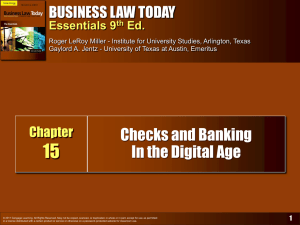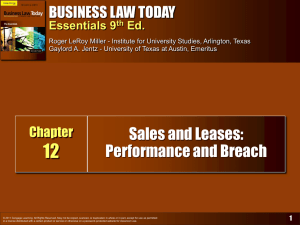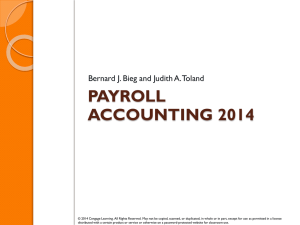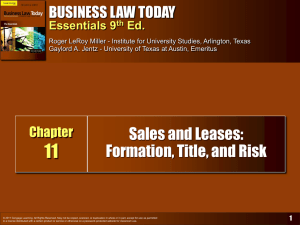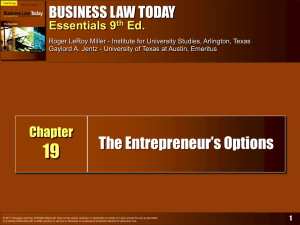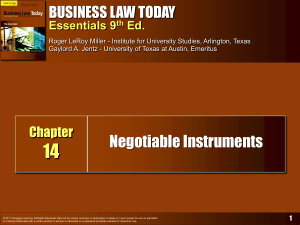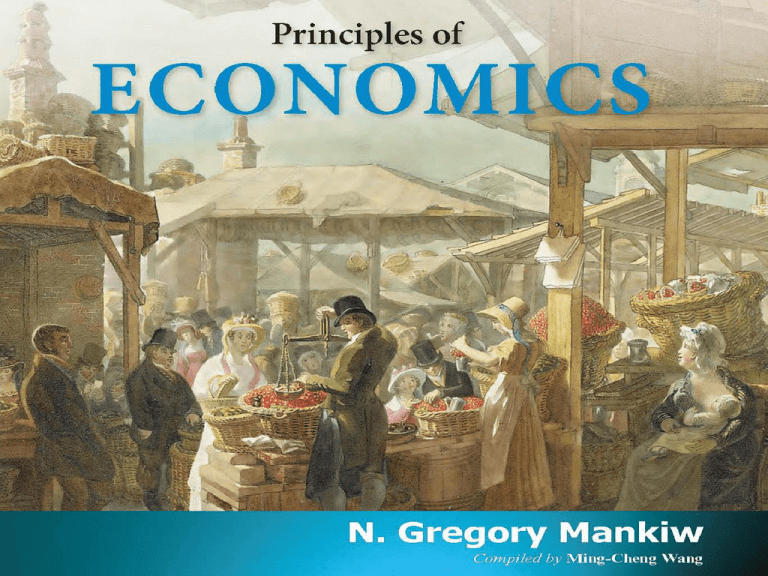
PowerPoint Slides prepared by:
Andreea CHIRITESCU
Eastern Illinois University
© 2015 Cengage Learning. All Rights Reserved. May not be copied, scanned, or duplicated, in whole or in part, except for use as
permitted in a license distributed with a certain product or service or otherwise on a password-protected website for classroom use.
1
6
Supply, Demand,
and Government Policies
PowerPoint Slides prepared by:
Andreea CHIRITESCU
Eastern Illinois University
© 2015 Cengage Learning. All Rights Reserved. May not be copied, scanned, or duplicated, in whole or in part, except for use as
permitted in a license distributed with a certain product or service or otherwise on a password-protected website for classroom use.
2
Controls on Prices
• Price controls
– Usually enacted when policymakers
believe that the market price of a good or
service is unfair to buyers or sellers
– Can generate inequities
• Taxes
– Used to raise revenue for public purposes
and to influence market outcomes
© 2015 Cengage Learning. All Rights Reserved. May not be copied, scanned, or duplicated, in whole or in part, except for use as
permitted in a license distributed with a certain product or service or otherwise on a password-protected website for classroom use.
3
Controls on Prices
• Price ceiling
– A legal maximum on the price at which a
good can be sold
• Price floor
– A legal minimum on the price at which a
good can be sold
© 2015 Cengage Learning. All Rights Reserved. May not be copied, scanned, or duplicated, in whole or in part, except for use as
permitted in a license distributed with a certain product or service or otherwise on a password-protected website for classroom use.
4
Controls on Prices
How price ceilings affect market outcomes
– Not binding
• Set above the equilibrium price
• No effect on the price or quantity sold
– Binding constraint
• Set below the equilibrium price
• Shortage
• Sellers must ration the scarce goods
– Long lines
– Discrimination according to sellers bias
© 2015 Cengage Learning. All Rights Reserved. May not be copied, scanned, or duplicated, in whole or in part, except for use as
permitted in a license distributed with a certain product or service or otherwise on a password-protected website for classroom use.
5
Figure 1
A Market with a Price Ceiling
(a) A Price Ceiling That Is Not Binding
Price of Ice-Cream
Cones
(b) A Price Ceiling That Is Binding
Price of Ice-Cream
Cones
Supply
Supply
Price ceiling
$4
Equilibrium
price
$3
3
Equilibrium
price
Price ceiling
2
Demand
Shortage
Quantity
supplied
Equilibrium
quantity
0
100
Quantity of Ice-Cream Cones
0
Demand
Quantity
demanded
125
75
Quantity of Ice-Cream Cones
In panel (a), the government imposes a price ceiling of $4. Because the price ceiling is above the
equilibrium price of $3, the price ceiling has no effect, and the market can reach the equilibrium
of supply and demand. In this equilibrium, quantity supplied and quantity demanded both equal
100 cones. In panel (b), the government imposes a price ceiling of $2. Because the price ceiling
is below the equilibrium price of $3, the market price equals $2. At this price, 125 cones are
demanded and only 75 are supplied, so there is a shortage of 50 cones.
© 2015 Cengage Learning. All Rights Reserved. May not be copied, scanned, or duplicated, in whole or in part, except for use as
permitted in a license distributed with a certain product or service or otherwise on a password-protected website for classroom use.
6
Lines at the gas pump
• 1973, OPEC raised the price of crude oil
– Reduced the supply of gasoline
– Long lines at gas stations
• What was responsible for the long gas
lines?
– OPEC
• Shortage of gasoline
– U.S. government regulations
• Price ceiling on gasoline
© 2015 Cengage Learning. All Rights Reserved. May not be copied, scanned, or duplicated, in whole or in part, except for use as
permitted in a license distributed with a certain product or service or otherwise on a password-protected website for classroom use.
7
Lines at the gas pump
• Price ceiling on gasoline
– Before OPEC raised the price of crude oil
• Equilibrium price was below the price ceiling
– No effect on the market
– When the price of crude oil rose
• Decrease in the supply of gasoline
• Equilibrium price was above the price ceiling
– Binding price ceiling
– Severe shortage
• Laws regulating the price of gasoline
were repealed
© 2015 Cengage Learning. All Rights Reserved. May not be copied, scanned, or duplicated, in whole or in part, except for use as
permitted in a license distributed with a certain product or service or otherwise on a password-protected website for classroom use.
8
Figure 2
The Market for Gasoline with a Price Ceiling
(a) The Price Ceiling On Gasoline Is Not Binding
Price of Gasoline
1. Initially, the price
ceiling is not binding …
Supply, S1
(b) The Price Ceiling On Gasoline Is Binding
Price of Gasoline
S2
S1
P2
Price ceiling
Price ceiling
3…the price
ceiling becomes
binding…
P1
P1
4. …resulting
in a shortage
Demand
Demand
0
Q1
Quantity of Gasoline
2…but when
supply falls…
0
QS
QD
Q1
Quantity of Gasoline
Panel (a) shows the gasoline market when the price ceiling is not binding because the equilibrium price,
P1, is below the ceiling. Panel (b) shows the gasoline market after an increase in the price of crude oil
(an input into making gasoline) shifts the supply curve to the left from S 1 to S2. In an unregulated
market, the price would have risen from P1 to P2. The price ceiling, however, prevents this from
happening. At the binding price ceiling, consumers are willing to buy Q D, but producers of gasoline are
willing to sell only QS. The difference between quantity demanded and quantity supplied, Q D – QS,
measures the gasoline shortage.
© 2015 Cengage Learning. All Rights Reserved. May not be copied, scanned, or duplicated, in whole or in part, except for use as
permitted in a license distributed with a certain product or service or otherwise on a password-protected website for classroom use.
9
Rent control in the short run and the long run
• Price ceiling: rent control
– Local government places a ceiling on
rents
– Goal: to help the poor
• Making housing more affordable
– Critique
• Highly inefficient way to help the poor raise
their standard of living
© 2015 Cengage Learning. All Rights Reserved. May not be copied, scanned, or duplicated, in whole or in part, except for use as
permitted in a license distributed with a certain product or service or otherwise on a password-protected website for classroom use.
10
Rent control in the short run and the long run
• Adverse effects in the short run
– Supply and demand for housing are
relatively inelastic
– Small shortage
– Reduced rents
© 2015 Cengage Learning. All Rights Reserved. May not be copied, scanned, or duplicated, in whole or in part, except for use as
permitted in a license distributed with a certain product or service or otherwise on a password-protected website for classroom use.
11
Rent control in the short run and the long run
• Adverse effects in the long run
– Supply and demand are more elastic
• Landlords
– Are not building new apartments
– Are failing to maintain existing ones
• People
– Find their own apartments
– Induce more people to move into a city
• Large shortage of housing
© 2015 Cengage Learning. All Rights Reserved. May not be copied, scanned, or duplicated, in whole or in part, except for use as
permitted in a license distributed with a certain product or service or otherwise on a password-protected website for classroom use.
12
Rent control in the short run and the long run
• Adverse effects in the long run
– Rationing mechanisms
• Long waiting lists
• Preference to tenants without children
• Discriminate on the basis of race
• Bribes to building superintendents
• People respond to incentives
– Free markets
• Landlords – clean and safe buildings
• Higher prices
© 2015 Cengage Learning. All Rights Reserved. May not be copied, scanned, or duplicated, in whole or in part, except for use as
permitted in a license distributed with a certain product or service or otherwise on a password-protected website for classroom use.
13
Rent control in the short run and the long run
• People respond to incentives
– Rent control
• Shortages and waiting lists
• Landlords lose their incentive to respond to
tenants’ concerns
• Tenants get lower rents and lower-quality
housing
• Policymakers – additional regulations
– Difficult and costly to enforce
© 2015 Cengage Learning. All Rights Reserved. May not be copied, scanned, or duplicated, in whole or in part, except for use as
permitted in a license distributed with a certain product or service or otherwise on a password-protected website for classroom use.
14
Figure 3
Rent Control in the Short Run and in the Long Run
(a) Rent Control in the Short Run
(supply and demand are inelastic)
Rental Price of Apartment
(b) Rent Control in the Long Run
(supply and demand are elastic)
Rental Price of Apartment
Supply
Supply
Controlled rent
Controlled rent
Shortage
Demand
Demand
Shortage
0
Quantity of Apartments
0
Quantity of Apartments
Panel (a) shows the short-run effects of rent control: Because the supply and demand for
apartments are relatively inelastic, the price ceiling imposed by a rent-control law causes only a
small shortage of housing. Panel (b) shows the long-run effects of rent control: Because the
supply and demand for apartments are more elastic, rent control causes a large shortage.
© 2015 Cengage Learning. All Rights Reserved. May not be copied, scanned, or duplicated, in whole or in part, except for use as
permitted in a license distributed with a certain product or service or otherwise on a password-protected website for classroom use.
15
Controls on Prices
How price floors affect market outcomes
– Not binding
• Set below the equilibrium price
• No effect on the market
– Binding constraint
• Set above the equilibrium price
• Surplus
• Some sellers are unable to sell what they
want
– The rationing mechanisms: not desirable
© 2015 Cengage Learning. All Rights Reserved. May not be copied, scanned, or duplicated, in whole or in part, except for use as
permitted in a license distributed with a certain product or service or otherwise on a password-protected website for classroom use.
16
Figure 4
A Market with a Price Floor
(A) A Price Floor That Is Not Binding
Price of Ice-Cream
Cone
(B) A Price Floor That Is Binding
Price of Ice-Cream
Cone
Supply
Surplus
Supply
$4
Price floor
3
$3
Equilibrium
price
2
Equilibrium
price
Price floor
Demand
Demand
Quantity
demanded
Equilibrium
quantity
0
100
Quantity of Ice-Cream Cones
0
Quantity
supplied
120
80
Quantity of Ice-Cream Cones
In panel (a), the government imposes a price floor of $2. Because this is below the equilibrium
price of $3, the price floor has no effect. The market price adjusts to balance supply and
demand. At the equilibrium, quantity supplied and quantity demanded both equal 100 cones. In
panel (b), the government imposes a price floor of $4, which is above the equilibrium price of
$3. Therefore, the market price equals $4. Because 120 cones are supplied at this price and
only 80 are demanded, there is a surplus of 40 cones.
© 2015 Cengage Learning. All Rights Reserved. May not be copied, scanned, or duplicated, in whole or in part, except for use as
permitted in a license distributed with a certain product or service or otherwise on a password-protected website for classroom use.
17
The minimum wage
• Price floor: minimum wage
– Lowest price for labor that any employer
may pay
• Fair Labor Standards Act of 1938
– Ensure workers a minimally adequate
standard of living
• 2012, federal minimum wage, $7.25/hour
– Some states mandate minimum wages
above the federal level
© 2015 Cengage Learning. All Rights Reserved. May not be copied, scanned, or duplicated, in whole or in part, except for use as
permitted in a license distributed with a certain product or service or otherwise on a password-protected website for classroom use.
18
The minimum wage
• France
– Average income is 27% lower than in the
U.S.
– Minimum wage 9.40 euros per hour ($12)
• Market for labor
– Workers supply labor
– Firms demand labor
© 2015 Cengage Learning. All Rights Reserved. May not be copied, scanned, or duplicated, in whole or in part, except for use as
permitted in a license distributed with a certain product or service or otherwise on a password-protected website for classroom use.
19
The minimum wage
• If minimum wage is above equilibrium
– Unemployment
– Higher income for workers who have jobs
– Lower income for workers who cannot
find jobs
• Impact of the minimum wage on highly
skilled and experienced workers
– No effect: their equilibrium wages are well
above the minimum
– Minimum wage - not binding
© 2015 Cengage Learning. All Rights Reserved. May not be copied, scanned, or duplicated, in whole or in part, except for use as
permitted in a license distributed with a certain product or service or otherwise on a password-protected website for classroom use.
20
The minimum wage
• Impact of the minimum wage on teenage
labor
– Least skilled and least experienced
– Low equilibrium wages
– Willing to accept a lower wage in
exchange for on-the-job training
– Minimum wage – binding
© 2015 Cengage Learning. All Rights Reserved. May not be copied, scanned, or duplicated, in whole or in part, except for use as
permitted in a license distributed with a certain product or service or otherwise on a password-protected website for classroom use.
21
The minimum wage
• Teenage labor market
– A 10% increase in the minimum wage
depresses teenage employment between
1 and 3%
– Some teenagers who are still attending
high school choose to drop out and take
jobs
• Displace other teenagers who had already
dropped out of school and who now become
unemployed
© 2015 Cengage Learning. All Rights Reserved. May not be copied, scanned, or duplicated, in whole or in part, except for use as
permitted in a license distributed with a certain product or service or otherwise on a password-protected website for classroom use.
22
Figure 5
How the Minimum Wage Affects the Labor Market
(b) A Labor Market with a
Binding Minimum Wage
(a) A Free Labor Market
Wage
Wage
Labor
supply
Minimum
wage
Equilibrium
wage
0
Labor
supply
Labor surplus
(unemployment)
Labor
demand
Labor
demand
Equilibrium
employment
Quantity
of Labor
0
Quantity
demanded
Quantity Quantity
supplied of Labor
Panel (a) shows a labor market in which the wage adjusts to balance labor supply and labor
demand. Panel (b) shows the impact of a binding minimum wage. Because the minimum wage is
a price floor, it causes a surplus: The quantity of labor supplied exceeds the quantity demanded.
The result is unemployment.
© 2015 Cengage Learning. All Rights Reserved. May not be copied, scanned, or duplicated, in whole or in part, except for use as
permitted in a license distributed with a certain product or service or otherwise on a password-protected website for classroom use.
23
Evaluating Price Controls
• Markets are usually a good way to
organize economic activity
– Economists usually oppose price ceilings
and price floors
– Prices are not the outcome of some
haphazard process
– Prices have the crucial job of balancing
supply and demand
• Coordinating economic activity
© 2015 Cengage Learning. All Rights Reserved. May not be copied, scanned, or duplicated, in whole or in part, except for use as
permitted in a license distributed with a certain product or service or otherwise on a password-protected website for classroom use.
24
Evaluating Price Controls
• Governments can sometimes improve
market outcomes
– Want to use price controls
• Because of unfair market outcome
• Aimed at helping the poor
– Often hurt those they are trying to help
– Other ways of helping those in need
• Rent subsidies
• Wage subsidies
© 2015 Cengage Learning. All Rights Reserved. May not be copied, scanned, or duplicated, in whole or in part, except for use as
permitted in a license distributed with a certain product or service or otherwise on a password-protected website for classroom use.
25
Taxes
• Government use taxes
– To raise revenue for public projects
• Roads, schools, and national defense
• Tax incidence
– Manner in which the burden of a tax is
shared among participants in a market
© 2015 Cengage Learning. All Rights Reserved. May not be copied, scanned, or duplicated, in whole or in part, except for use as
permitted in a license distributed with a certain product or service or otherwise on a password-protected website for classroom use.
26
Taxes
How taxes on sellers affect market
outcomes
– Immediate impact on sellers: shift in
supply
– Supply curve shifts left
– Higher equilibrium price
– Lower equilibrium quantity
– The tax reduces the size of the market
© 2015 Cengage Learning. All Rights Reserved. May not be copied, scanned, or duplicated, in whole or in part, except for use as
permitted in a license distributed with a certain product or service or otherwise on a password-protected website for classroom use.
27
Figure 6
A Tax on Sellers
Price
buyers
pay
Price
without
tax
Price of
Ice-Cream
Cone
Equilibrium with tax
S2
S1
A tax on sellers
shifts the supply
curve upward
by the size of
the tax ($0.50).
$3.30
Tax ($0.50)
3.00
Equilibrium
without tax
2.80
Price
sellers
receive
Demand, D1
0
90
100
Quantity of
Ice-Cream Cones
When a tax of $0.50 is levied on sellers, the supply curve shifts up by $0.50 from S 1 to S2. The
equilibrium quantity falls from 100 to 90 cones. The price that buyers pay rises from $3.00 to
$3.30. The price that sellers receive (after paying the tax) falls from $3.00 to $2.80. Even though
the tax is levied on sellers, buyers and sellers share the burden of the tax.
© 2015 Cengage Learning. All Rights Reserved. May not be copied, scanned, or duplicated, in whole or in part, except for use as
permitted in a license distributed with a certain product or service or otherwise on a password-protected website for classroom use.
28
Taxes
How taxes on sellers affect market
outcomes
– Taxes discourage market activity
– Buyers and sellers share the burden of tax
– Buyers pay more, are worse off
– Sellers receive less, are worse off
• Get the higher price but pay the tax
• Overall: effective price fall
© 2015 Cengage Learning. All Rights Reserved. May not be copied, scanned, or duplicated, in whole or in part, except for use as
permitted in a license distributed with a certain product or service or otherwise on a password-protected website for classroom use.
29
Taxes
How taxes on buyers affect market
outcomes
– Initial impact on the demand
– Demand curve shifts left
– Lower equilibrium price
– Lower equilibrium quantity
– The tax reduces the size of the market
© 2015 Cengage Learning. All Rights Reserved. May not be copied, scanned, or duplicated, in whole or in part, except for use as
permitted in a license distributed with a certain product or service or otherwise on a password-protected website for classroom use.
30
Figure 7
A Tax on Buyers
Price
buyers
pay
Price
without
tax
Price of
Ice-Cream
Cone
Equilibrium with tax
Equilibrium without tax
Supply, S1
A tax on buyers
shifts the demand
curve downward
by the size of
the tax ($0.50).
$3.30
3.00
Tax ($0.50)
2.80
Price
sellers
receive
D1
D2
0
90
100
Quantity of
Ice-Cream Cones
When a tax of $0.50 is levied on buyers, the demand curve shifts down by $0.50 from D 1 to D2.
The equilibrium quantity falls from 100 to 90 cones. The price that sellers receive falls from $3.00
to $2.80. The price that buyers pay (including the tax) rises from $3.00 to $3.30. Even though the
tax is levied on buyers, buyers and sellers share the burden of the tax.
© 2015 Cengage Learning. All Rights Reserved. May not be copied, scanned, or duplicated, in whole or in part, except for use as
permitted in a license distributed with a certain product or service or otherwise on a password-protected website for classroom use.
31
Taxes
How taxes on buyers affect market
outcomes
– Buyers and sellers share the burden of tax
– Sellers get a lower price, are worse off
– Buyers pay a lower market price, are
worse off
• Effective price (with tax) rises
© 2015 Cengage Learning. All Rights Reserved. May not be copied, scanned, or duplicated, in whole or in part, except for use as
permitted in a license distributed with a certain product or service or otherwise on a password-protected website for classroom use.
32
Taxes
Taxes levied on sellers and taxes levied on
buyers are equivalent
– Wedge between the price that buyers pay
and the price that sellers receive
• The same, regardless of whether the tax is
levied on buyers or sellers
– Shifts the relative position of the supply
and demand curves
• Buyers and sellers share the tax burden
© 2015 Cengage Learning. All Rights Reserved. May not be copied, scanned, or duplicated, in whole or in part, except for use as
permitted in a license distributed with a certain product or service or otherwise on a password-protected website for classroom use.
33
Can Congress distribute the burden of a
payroll tax?
• Payroll taxes
– Deducted from the amount you earned
• By law, the tax burden:
– Half of the tax is paid by firms
• Out of firm’s revenue
– Half of the tax is paid by workers
• Deducted from workers’ paychecks
© 2015 Cengage Learning. All Rights Reserved. May not be copied, scanned, or duplicated, in whole or in part, except for use as
permitted in a license distributed with a certain product or service or otherwise on a password-protected website for classroom use.
34
Can Congress distribute the burden of a
payroll tax?
• Tax incidence analysis
– Payroll tax as a tax on a good
• The good is labor
• The price is the wage
• Introduce payroll tax
– Wage received by workers falls
– Wage paid by firms rises
– Workers and firms share the tax burden
• Not necessarily 50-50 as required
© 2015 Cengage Learning. All Rights Reserved. May not be copied, scanned, or duplicated, in whole or in part, except for use as
permitted in a license distributed with a certain product or service or otherwise on a password-protected website for classroom use.
35
Can Congress distribute the burden of a
payroll tax?
• Lawmakers
– Can decide whether a tax comes from the
buyer’s pocket or from the seller’s
– Cannot legislate the true burden of a tax
• Tax incidence
– Determined by the forces of supply and
demand
© 2015 Cengage Learning. All Rights Reserved. May not be copied, scanned, or duplicated, in whole or in part, except for use as
permitted in a license distributed with a certain product or service or otherwise on a password-protected website for classroom use.
36
Figure 8
A Payroll Tax
Wage
Labor
supply
Wage firms pay
Tax wedge
Wage without tax
Wage workers
receive
Labor
demand
0
Quantity of
Labor
A payroll tax places a wedge between the wage that workers receive and the wage that firms pay.
Comparing wages with and without the tax, you can see that workers and firms share the tax
burden. This division of the tax burden between workers and firms does not depend on whether
the government levies the tax on workers, levies the tax on firms, or divides the tax equally
between the two groups.
© 2015 Cengage Learning. All Rights Reserved. May not be copied, scanned, or duplicated, in whole or in part, except for use as
permitted in a license distributed with a certain product or service or otherwise on a password-protected website for classroom use.
37
Taxes
• Elasticity and tax incidence
– Very elastic supply and relatively inelastic
demand
• Sellers bear a small burden of tax
• Buyers bear most of the burden
– Relatively inelastic supply and very elastic
demand
• Sellers bear most of the tax burden
• Buyers bear a small burden
© 2015 Cengage Learning. All Rights Reserved. May not be copied, scanned, or duplicated, in whole or in part, except for use as
permitted in a license distributed with a certain product or service or otherwise on a password-protected website for classroom use.
38
Figure 9
How the Burden of a Tax Is Divided (a)
(a) Elastic Supply, Inelastic Demand
Price
1. When supply is more
elastic than demand . . .
Supply
Price buyers pay
2. . . . the incidence of
the tax falls more heavily
on consumers . . .
Tax
Price without tax
Price sellers
receive
3. . . . than on producers.
Demand
0
Quantity
In panel (a), the supply curve is elastic, and the demand curve is inelastic. In this case, the price
received by sellers falls only slightly, while the price paid by buyers rises substantially. Thus,
buyers bear most of the burden of the tax.
© 2015 Cengage Learning. All Rights Reserved. May not be copied, scanned, or duplicated, in whole or in part, except for use as
permitted in a license distributed with a certain product or service or otherwise on a password-protected website for classroom use.
39
Figure 9
How the Burden of a Tax Is Divided (b)
(b) Inelastic Supply, Elastic Demand
Price
1. When demand is more
elastic than supply . . .
Supply
Price buyers pay
3. than on consumers
Price without tax
Tax
Demand
2. . . . the incidence of
the tax falls more
heavily on producers.
Price sellers
receive
0
Quantity
In panel (b), the supply curve is inelastic, and the demand curve is elastic. In this case, the
price received by sellers falls substantially, while the price paid by buyers rises only slightly.
Thus, sellers bear most of the burden of the tax.
© 2015 Cengage Learning. All Rights Reserved. May not be copied, scanned, or duplicated, in whole or in part, except for use as
permitted in a license distributed with a certain product or service or otherwise on a password-protected website for classroom use.
40
Taxes
• Tax burden
– Falls more heavily on the side of the
market that is less elastic
– Small elasticity of demand
• Buyers do not have good alternatives to
consuming this good
– Small elasticity of supply
• Sellers do not have good alternatives to
producing this good
© 2015 Cengage Learning. All Rights Reserved. May not be copied, scanned, or duplicated, in whole or in part, except for use as
permitted in a license distributed with a certain product or service or otherwise on a password-protected website for classroom use.
41
Who pays the luxury tax?
• 1990, Congress adopted a new luxury
tax
– On yachts, private airplanes, furs,
jewelry, expensive cars
– Goal: to raise revenue from those who
could most easily afford to pay
– Luxury items
• Demand is quite elastic
• Supply is relatively inelastic
© 2015 Cengage Learning. All Rights Reserved. May not be copied, scanned, or duplicated, in whole or in part, except for use as
permitted in a license distributed with a certain product or service or otherwise on a password-protected website for classroom use.
42
Who pays the luxury tax?
• Outcome:
– Burden of a tax falls largely on the
suppliers
• Relatively inelastic supply
• 1993: most of the luxury tax was
repealed
“If this boat were any more
expensive, we’d be playing
golf.”
© 2015 Cengage Learning. All Rights Reserved. May not be copied, scanned, or duplicated, in whole or in part, except for use as
permitted in a license distributed with a certain product or service or otherwise on a password-protected website for classroom use.
43



